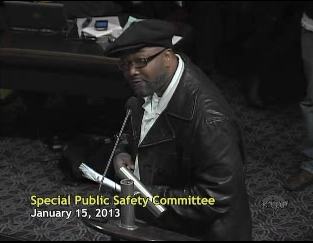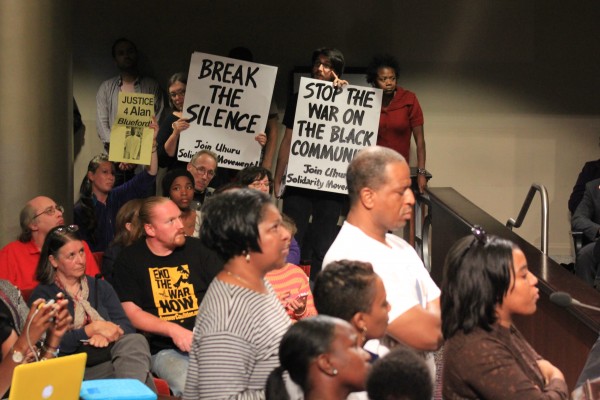24 June 2014
The people of Oakland showed up in force today to support the changing of the city charter to require the city to staff a commission, called the Public Safety Oversight Commission, to hold historically violent and irresponsible Oakland police accountable for their illegal and otherwise violent and inappropriate actions. This hearing was held by the Public Safety Commission, whose members are Noel Gallo, chairman of the committee and sponsor of the item, Dan Kalb, Libby Schaaf, and Lynette Gibson McElhaney.
Speakers in favor of this change spoke to everything from the lack of police service to the inappropriate and violent responses by OPD, which have gone on for decades with impunity. Often, even in the case of murder by officer Miguel Masso of young Alan Blueford, officers, instead of being investigated and charged with the crimes they’ve committed, officers are put on ‘paid administrative leave’ aka vacation. The public is kept in the dark as to any action taken against officers by OPD internal affairs or the Citizens Police Review Board, which shares all information given to them by complainants, making it a dangerous action to file complaints at all.
Alan Blueford’s mother, Jeralyn Blueford, spoke, in tears, to remind us that Miguel Masso had a history of police violence and misconduct before ever being hired by the city to be in power to murder her son. ‘We shall not tolerate this and officers will be held to a higher standard…’
One speaker mentioned the value of civilianizing public safety functions when possible, allowing sworn officers to spend their time out in the streets serving the people.
Mayoral candidate Dan Siegel spoke about the millions and millions of dollars lost to lawsuits from OPD conduct. He advised the council to confer with OPOA, the police union, regarding the issue. He said the voters have a right to decide this, but OPOA can be involved in the process. He urged, as did most other speakers, the placing of this issue on the ballot.
One woman insisted upon calling protestors ‘rioters’ … having seemingly missed the miles of video evidence that it was OPD who were rioting during the height of Occupy Oakland actions. She also urged council to place this on the ballot, and acknowledged councilmember Noel Gallo for showing great leadership in this effort.
Isaac Taggart, with PUEBLO, pushed the council to vote to put this measure on the ballot. ‘You cannot afford to vote no or abstain … we will remind you at the polls.’ He spoke about the large number of unemployed black men in the city, and drew the connection of poverty being a major cause of crime.
Oakland Police officer Frank Marrow, a 26 year public servant with a law degree, spoke about accountability needing to happen from the top of the organization. He mentioned the consent decree. He acknowledged that ‘they’re running a game’ … suggesting that attorneys are making millions of dollars off the consent decree and other attempts to reign in violent police. He said ‘I’m too radical because I believe in telling you the truth of the OPOA, and too blue for Burris.’ He wants to see ‘a police department that is constitutional.’
When councilmember Pat Kernighan stood up to speak, Gallo recognized the attendance as constituting a full council. She attempted, with earned interruptions, to suggest that what she sees as recent improvements in the efforts by OPD to comply with the consent decree makes this charter change unnecessary. She suggested, also, that the CPRB could somehow magically change the culture of the police department. She spoke in opposition to placing the measure on the ballot.
Attorney Yolanda Huang reminded us all that the foundation of appropriate prosecution of criminal action is banked in complete, true, and honest reporting by police. This is something on which we should all be able to depend, and which is not the way OPD officers do their reporting.
Akiba Bradford, a researcher in the criminal justice/juvenile justice system said, ‘The numbers don’t add up … in order for there to be a change in culture there also has to be a change in oversight.’
Sange Basha’s only question isn’t ‘why would you put this on the ballot, but why wouldn’t you?’ She spoke to the economics of spending the money to hold police accountable. She says the measure is ‘revenue neutral,’ mentioning the $70 million lost to lawsuits and settlements in the recent decade.
Jasmin Coleman is a seventeen year old youth, involved with PUEBLO. She spoke to the teachings of her elders, explaining that we are taught that we will be held accountable for our actions, but police are not. She said she is afraid of police, and that people have to protect ourselves, because police aren’t doing it.
J. Jones with PUEBLO and Oakland Youth Policy Builders mentioned hearing what he called ‘crazy stories’ about police brutality. ‘There’s no reason to wait. Put it on the ballot now, give people of Oakland a chance to decide for ourselves.’
Rashida Grinage, also from PUEBLO, spoke about the politics of the issue. ‘what you have before you in the way of a ballot measure is defined … no controversy … because it is also the work of several months of many many people in the community … from the point of view of process, we don’t have any red lines … we have agreement … we don’t have an disagreement from you … ‘ She suggested the council/committee members aren’t disagreeing possibly because they’re not considering this a real possibility. She said, ‘we’ve done the work in the community, and we are all of one mind … ‘ She went on to say, ‘we want to work with you, not against you … ‘ and delivered words of appreciation for Noel Gallo for being willing to take on what she called a ‘thorny’ issue. ‘This is time for this community to realize accountability, and we hope that you will not stand in the way of that.’
Oakland Police Chief Whendt said he agrees with Jeralyn Blueford that police should be held to a higher standard. While he claimed to be dedicated to holding officers and the department accountable, and feels that he’s making progress since coming on board as chief, he doesn’t claim to know that it’s ‘enough.’
Patrick Caceras, manager and policy analyst for the CPRP, who refused to give an opinion previous to this meeting, said that the CPRB is going through changes. While never actually stating an opinion about the proposal, he meandered around it only to compare the concept of the Public Safety Oversight Commission to the current CPRB, with, of course, increased powers. Being the person most able to acknowledge the failure of the CPRB, as it is defined, to actually do anything about police violence, he managed to state no opinion.
While acknowledging that this is an effort to actually change the city charter, Libby Schaaf asked the city attorney to explain if there was a way to create this commission without a ballot measure. In fact, as an attorney, one would think she would understand that a change such as this would require a charter amendment. This is partly the answer given by the city attorney, qualified with a statement that the office would need to do more work to completely answer the query.
Three of these committee members were elected to office in the most recent past election. Only Libby Schaaf has tenure on council.
Dan Kalb admitted to not having read the entire proposal. He said he looked into the Los Angeles version of this type of commission. He suggested that combining the current CPRB and CPAB into such a commission ‘could work.’ While stating that he is open to this concept, he never really stated support for putting this measure on the ballot. ‘I don’t know if now, when we’re under the NSA, the public should be asked.’ He clarified that he’s not against the idea, but wanting to change the language of the proposal, after community members spent months drafting this proposal, that he did not bother to read it.
‘This subject is always a tough one for me. It’s difficult when we wade into these waters’ were some of the first words out of Lynette Gibson McElhaney. She talked of growing up in gangland, made a weepy attempt to acknowledge the pain expressed by the people, then stated she wasn’t certain this was the ‘appropriate remedy.’ She also, like Kalb, acknowledged not reading the entire proposal. ‘We often think we’re gonna fix something with something, but we don’t think it all the way through’ were the words she used to suggest that this proposal is less than optimum. She claimed to have worked hard to reform the CPRB, which is notorious for having no teeth to actually stop police brutality and misconduct, and basically undermined the work of the many folks who worked so hard to develop and deliver this proposal.
Noel Gallo repeatedly mentioned ‘by the people, for the people,’ referring often to the fact that we, the people, are paying for the services of everyone from members of OUSD, to the city attorney. He thanked the people for working so hard on this effort. ‘Out of your effort and out of your push to have a better Oakland … the reality is on the neighborhood, and all the polling says … there’s lack of confidence, not only in the police department, but in my neighborhood.’ He basically went off on the CPRB for never providing the required bi-annual reports to the committee and council, and reminded us all that the proposal for a public safety commission looks very much like what the CPRB was supposed to have been doing for many years.
Gallo thanked everyone for informing him about everything from community policing to CPRB regulations and the power of the public safety committee to oversee the CPRB.
When chairman Gallo asked for a motion to approve the recommendation to send this proposal to council for consideration, Libby Schaaf immediately spoke against doing so. She suggesting putting this off ‘until the fall.’ As a reminder, this is a proposal for council to include this on the next ballot. Schaaf’s effort is to stall to make that impossible. McElhaney followed suit, wondering whether there was any ordinance which could do what this proposal is trying to do. Kalb said ‘this is not an attempt to bury the motion’ while joining forces with Schaaf and Mcelhaney to stuff the effort into the trash heap. He spoke only negatively.
Item stays in committee.




